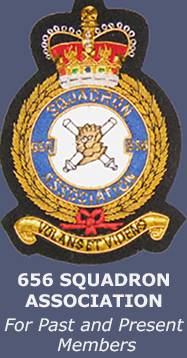The History of 656 Squadron
From 31 December 1942 to the present
Copyright © 2013 Guy Warner.
The author has granted permission to reproduce the following excerpts from the book “From “Auster to Apache, The history of 656 Squadron RAF/AAC 1942-2012”.
656 Air Observation Post (AOP) Squadron, Royal Air Force, was formed at the R.A.F. Station Westley, on 31 December 1942. The aircraft arrived in February, 1943, and the Squadron then moved to R.A.F. Stapleford Tawney. Training over the next four months involved manoeuvres with Army units throughout the UK, including live shoots on Artillery Ranges.
Forming the Squadron was a matter of collecting together pilots, aircraft, soldiers, airmen and vehicles and turning them into a flying and fighting unit. Initially the soldiers and airmen were a trifle suspicious of each other until they found that they were both exactly the same underneath their different uniforms. Many friendships quickly developed, and years later the prevailing mood within the Squadron at that time was described by Bombadier Ernest Smith,
‘We were about half-and-half RAF and Royal Artillery and we got on together wonderfully – a bit of banter, naturally, about Brylcreem Boys and Brown Jobs – but we lived together, messed together and went out on the town together. The officers, with the exception of the Adjutant and the Equipment Officer, who were RAF, were all Royal Artillery and young. The whole outfit was informal, cheerful and matey.’
At that time six AOP squadrons, of which the most recent was 656, had been formed. The first, 651, had been on active service in North Africa since November 1942, where it would be joined in March 1943 by 654, and five months later by 655. Two other squadrons, 652 and 653, were engaged in training and exercises in Scotland and England respectively. They too would go to war, but not until after the invasion of occupied Europe in June 1944. In the two years between January 1943 and March 1945, ten more AOP squadrons would be formed (657 to 666), all of which would serve in Italy, France, Holland or Germany.
656 Squadron would be, however, unique; after their initial training, at the beginning of August 1943 they were warned to prepare for a tropical destination – they were going to India, and from there on to Burma, where they were to be the only AOP Squadron to support the whole of the 14th Army, the ‘Forgotten Army’ throughout the Burma campaign.
There they were to be stretched to the limit – normally an AOP Flight of five aircraft would be deployed to support a Division, but in Burma a single section, consisting of only one Auster aircraft, was allocated to a Division.
Furthermore, the OC Denis Coyle was told he would have to find and train all his own replacement pilots, which required his setting up an AOP Training School in Deolali, India, staffed and run by his own Squadron personnel, spreading his already limited resources ever more thinly. This school was only partially successful, providing only eight pilots from two AOP courses, before he changed tack and formed 1587 (Refresher) Flight, which instead provided jungle training and theatre familiarization for newly-qualified pilots sent out from the AOP School in the UK. This approach proved much more productive, and in total more than 30 replacement pilots were trained in India before going to Burma.
Little did they know that once they had sailed from the UK, 656 Squadron was not to return from the Far East for almost thirty-five years; after WW2 it assisted the Dutch in their Java/Sumatra campaign, and then served throughout the 12-year Malayan Emergency from 1948 to 1960, Borneo and Brunei in the early 1960’s, and Hong Kong.
During this time it would complete in excess of 250,000 operational flying hours; this figure is believed to be a record unmatched by any Royal Navy, Army Air Corps or Royal Air Force squadron to this day.
Many of its pilots were also rotated through the two Independent AOP and Light Liaison Flights in the Korean war, which remained in theatre until early 1955, eighteen months after the Armistice.
Following re-establishment in the United Kingdom in 1978, its travels were far from over and it would add further operational laurels in Rhodesia, the Falkland Islands, Bosnia, Kosovo and, most recently Afghanistan and Libya, having become the first AAC Squadron to deploy operationally with the mighty Apache helicopter.
This, then, is the story of a quite remarkable unit.
